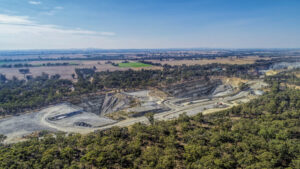Why your new bathroom is helping Strandline Resources build its mineral sands empire

Pic: Bloomberg Creative / Bloomberg Creative Photos via Getty Images
- Strandline Resources raises $50m to back expansion plans at key mineral sands assets
- MD Luke Graham says post-Covid building boom sent prices well beyond its Coburn DFS levels
- Demand from ceramics intensifies as homeowners favour larger tiles with higher zircon content
Home renovations, property builds, construction projects and infrastructure have all been supercharged by Government stimulus packages designed to prop up industries in the wake of the Covid-19 pandemic.
Now those growth hungry economic policies are coming home to roost, in a very positive way for producers of mineral sands, a suite of products uniquely geared to benefit from surging demand for construction materials just as the supply of the raw materials struggles to keep pace.
$500 million capped Strandline Resources (ASX:STA) is up 50% year to date and 115% over the past year, peaking at a high of 49c a share last week.
It has seen mineral sands prices soar to their highest levels in years, setting the stage perfectly for the start of production from its zircon and ilmenite rich Coburn project near Denham on the picturesque coastline of WA’s Shark Bay community.
Those products will go into ceramics for tiles and titanium dioxide feedstock for paint pigments, two markets that are booming.
Construction of the $338 million project is already 65% complete, with the first production of mineral sands concentrate due in the December Quarter.
It is projected to deliver some $4.4 billion in revenue over its 22.5 year mine life, producing 34,000t of premium zircon, 54,000t of zircon concentrate, 110,000t of chloride ilmenite and 24,000t of rutile for an average annual EBITDA of $104m.
But since Strandline’s mid-2020 DFS spot prices have risen 35% on its estimates with supply-demand metrics suggesting they could run further.
According to one of the industry’s largest players, ASX-listed Iluka Resources (ASX:ILU), its average weighted zircon price lifted from US$1,291/t in the fourth quarter of 2020 to $1,590/t in the fourth quarter of 2021 with another US$220/t lift in the March quarter just gone.
Data from industry analyst Ruidow shows that isn’t the end of the price rises, with Tronox recently lifting its zircon prices by US$100/t.
Strandline has capitalised on this bullish outlook by raising $50 million in a placement from institutional investors this week, providing funding to investigate further developments at its Fungoni and Tajiri mineral sands deposits in Tanzania and announcing studies into a 50% increase in its production capacity at Coburn due to outsized demand for its product before a single ship has left port.
Strandline MD Luke Graham caught up with Stockhead yesterday to talk about the mineral sands market and why the construction boom is so bullish for producers of zircon and titanium feedstocks.
Strandline (ASX:STA) share price today:
We’ve seen prices for zircon go up pretty significantly over the last few months while you’ve been building Coburn, what’s the supply and demand situation in that market?
“It’s a supply-demand deficit that’s emerging and all the analysts predicted it.
“So the demand is solid but supply is depleting due to a range of things, whether it’s declining grades of existing mines, or the maturing of them.
“We’ve had disruptions in mining output, as well, particularly at Richards Bay in South Africa, which is Rio Tinto’s asset. So that’s been disrupted and the demand is strong globally across various applications.
“With regards to zircon it represents about 55% of our revenue stream at Coburn and it’s also very similar for Fungoni.
“One of the one of the key trends for this is the ceramic sector generally represents about 50% of Zircon consumption globally and it’s really buoyant.
“Adding to the demand for zircon is that cosmetically consumers are going for larger format tiles. Even floor to ceiling tiles in some respects or big kitchen bench top tiles in lieu of the higher cost marble tiling, and that’s a trend in Europe. It’s a trend in America and to some extent in Asia.
“In a larger format tile double the amount of zircon roughly goes into every square foot of it.
“When you’ve got a ceramic grade zircon the whiteness has to be really good. It has to have a strong ZRO2 level and low impurities, which we have at Coburn.
“There are a fair bit of renovations going on from the stimulus the major economies around the world injected into the market in infrastructure as well.”
So that’s the zircon, what’s the titanium feedstock that you’re producing at Coburn?
“We will be producing ilmenite and it’s a chloride grade ilmenite. So that’s in comparison to a sulphate grade.
“Chloride is a higher spec ilmenite, has more TiO2 within the mineral and it’s a cleaner mineral, and the demand for chloride ilmenite is higher because it creates a lot less waste than sulphate.
“It has a different downstream production to extract the titanium dioxide and it’s where the future is. And we also produce a rutile product, which is the highest grade titanium feedstock, and what’s driving demand there is the paint sector in particular.
“So when you think about titanium feedstocks around the world, ilmenite and rutile and in some cases leucoxene, which sort of sits in the middle of ilmenite and rutile, in terms of titanium composition, the paint sector represents 90% and then titanium metal and welding rods and those sort of things are the balance of the last 10%.
“In America, particularly there was demand for paint through COVID essentially because a lot of people were staying at home and they were doing their DIY.
“Instead of traveling they were probably spending their funds on do it yourself projects. We saw that here in Australia as well, people painting their houses and that during lockdowns really drove demand but now it’s just coming through with the infrastructure and the level of construction globally and global growth.
“And look, the sector has been caught out a little bit. There’s been a real lack of investment like a lot of commodities. I’ve talked to some of my peers in different commodities, industrial minerals as well as the base metals and precious metals and there has been a general lack of investment in resources.
“In mineral sands there hasn’t been a major project of any real significance for some years and the big players are weaker, Rio Tinto, Iluka and Tronox. They don’t necessarily have the quality of the growth projects or the portfolio of growth projects they did 15 years ago.
“And that creates a great opportunity for Strandline which has got the growth projects to be put forward into the market. And we’re seeing that and hence why we did the capital raise to accelerate that and take advantage of it.
“Our brand profile is raising in the sector, our market share through Coburn is going to be material.
“We’ll produce roughly 5% of the global zircon market from Coburn, 10% of the global chloride ilmenite market, about 3-4% of the global rutile market indicatively. We’re even looking at potentially scaling up Coburn in the future once we’re in steady state and cash flow and all that sort of stuff in a few years’ time.
“We’re going to do a series of studies on that over the next 18 months and some of the funds will be used for those studies. And in parallel with that we’ll be really accelerating our preparations for our Tanzanian projects and hopefully be in a position as Coburn’s coming into production where we’re ready to pin our ears back on our next project.”
You mentioned the triopoly in the mineral sands market between Rio Tinto, Iluka and Tronox. How are companies at your level going to be able to find a position in that market where they can grow without being taken out?
“It’s good problem to have really, isn’t it? We can find a position in the market. Our corporate appeal is only going to intensify from here.
“We’re a publicly listed company and the shareholders will ultimately decide as to whether they accept Strandline being taken out.
“So we (will be) one of the lowest cost producers, we’ve got a really strong revenue to cost ratio, our operations are leading in terms of ESG in the industry, very sustainable, long-life assets and we’ll just get on and deliver that really well.
“Being taken over by other companies and things like that, that’s out of our control, really. We’ve just got to keep delivering our strategy.
“It’s not something I’m focused on at all but inevitably, as we continue to grow and be successful our appeal just continues to intensify.”
You were saying that the growth profile of those companies isn’t looking as strong as it did. So it does set up an environment where there’ll be looking for new projects, new resources?
“You would think so if they want to continue to hold market share in the sector, at least hold or potentially grow their market share.
“Let’s just say if they want to hold their market share, then they’re going to have to I suspect.
“I don’t want to misrepresent those companies at all but you expect that they’re going to have to increase their resource base over time.
“And look, one of the differentiators for Strandline is the quality of the mineral and that’s becoming more and more important.
“If you’ve got a mineral that is of a premium quality, such as a ceramic grade zircon, low impurities, or a higher titanium dioxide mineral, people are paying more and there’s more demand for a higher quality mineral that creates less waste and has lower impurities in it.
“Particularly one other very important consideration is low uranium-thorium. Some of the best ore bodies around the world have already been mined in that regard and one of the good things about the Coburn project and also the Fungoni project in Tanzania, and some of our exploration assets that we’ve tested the mineralogy of, is that we have a very low uranium thorium mineral.
“I can’t say that necessarily for other emerging opportunities in the sector but certainly quality of mineral is a key differentiator for us, and we feel as the world continues to to drive better environmental and social standards it’s going to become more and more a differentiator for us over the next few decades.”
Tanzania became a pretty tough place for mining companies to operate a few years ago with the scale of the rule changes in the mining industry. How have you found Tanzania now that you’re again looking at the development of those projects?
“Tanzania is a really rich mining jurisdiction, quite a lot like WA and Queensland if you like, where a whole array of mineral opportunities are there. It’s got a diverse mining sector.
“It was one of the best mining sectors prior to reform. As soon as the reform came out it surprised a lot of people and part of that reform was to try to clean up the sector and get rid of bad behaviour or bad practices.
“(They wanted) better standards of environmental social responsibility across the mining operations in country, hire local content, better knowledge transfer, better controls on exports and royalties.
“Just before Christmas, Strandline executed and signed our Strategic Framework Agreement with the Tanzanian government and there were three other international mining companies who did the same on the same day with the President.
“It was a big ceremony and that was a clear sign that the Tanzanian government is really supportive of the next generation of projects now that they feel they’ve got the base framework and the mining code to support growth.
“So they basically slowed it down and there was short term pain, but if you look at it in hindsight, longer term benefit is what I see.
“Now we’re in joint venture with them. We’ve established Nyati Mineral Sands as the company, which means ‘buffalo’ in Swahili, which the government suggested because it’s a powerful, really prestigious animal in Tanzania.
“They get a 16% free carried interest … once dividends are distributed, which is similar to the other agreements that got announced on the same day. They just want to get moving and it’s given us confidence now to make real definitive preparations for development in that country.”
When do you see the Fungoni and Tajiri FIDs being made?
“So we don’t want to get ahead of ourselves but we’re accelerating Fungoni now. In 2020 in April we announced the financing agreement for 100% of the debt for Fungoni with Nedbank CIB, a Tier One Investment Bank in South Africa.
“And with COVID escalating, we decided just to monitor the situation and not proceed.
“At that time we had 100% of our offtake going for the whole life of mine locked away under binding agreements. We had all our key major construction contracts in place and awarded and all we needed to do was secure the framework agreement with the Tanzanian government and then raise the balance of equity.
“We put that in a holding pattern whilst we monitored the Covid situation globally and I’m so glad we did because we wouldn’t have been able to send our key personnel around the world and particularly to Tanzania to build the project through that.
“At the same time, Coburn was really coming through and building momentum to a final investment decision.
“It’s the best thing that’s happened to us in terms of our sequencing of our projects. Fungoni was ready for FID back then. We’ve got about three to six months work over the next period now that we’re funded to proceed with that work to refresh it and get it back into that position.
“The construction phase is about 12 months, it’s a smaller, modular, relocatable design concept. Those offtake agreements have expired, so we’re reevaluating that offtake strategy and that’ll be critical to any final investment decision, as well as us finalising land access.
“But with the funds raised (this week), assuming the capex of the project hasn’t changed materially over the last year and a half, we could be fully funded right now with the Nedbank facility, once it gets refreshed, into production and cash flow of our second project.”
Related Topics

UNLOCK INSIGHTS
Discover the untold stories of emerging ASX stocks.
Daily news and expert analysis, it's free to subscribe.
By proceeding, you confirm you understand that we handle personal information in accordance with our Privacy Policy.








